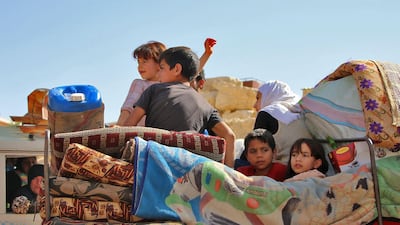At least 15,000 Syrian children are facing homelessness as their homes in north-east Lebanon are scheduled for demolition, international aid agencies warned on Tuesday.
Save the Children, World Vision and the Terre des hommes Foundation issued a statement calling on Lebanese authorities to halt the demolitions in Arsal until an alternative was found.
The Higher Defence Council announced in mid-April that informal settlements built by Syrian refugees with material other than timber and plastic sheeting must be dismantled before June 9.
After that date, non-compliant structures would be flattened.
The three charities say that more than 5,682 hard structures made of concrete are to be demolished. They house more than 25,000 people, including 15,000 children.
Other villages in neighbouring regions of Bekaa, Baalbeck and Hermel are expected to suffer similar fates, with several hundred families to be affected. No date has been set yet.
Mayssa, 59, has been living in Arsal since 2013 with her son, daughter-in-law and eight grandchildren aged 5 to 17.
She told the charities that when she heard about the planned demolition, she thought that she would have to “sleep on top of the children and have them demolish this home on our heads”.
Her granddaughter Salma, 12, said: “If they demolish our home, I just want to be with my mother, siblings and grandmother, all together. My dad is dead. I want to be with my family.”
The decision, which covers all illegal buildings in the Bekaa region, is aimed at discouraging Syrian refugees from staying in Lebanon by preventing them from building permanent houses, a Syrian activist told The National.
“They want to pressure people to go back to Syria but people are afraid of being arrested on return," the activist said.
There have been reports of refugees being summarily executed or imprisoned on return, and facing intimidation.
Damascus usually denies or does not comment on these types of claims.
But the reports fuel rumours among refugees, which discourage most of them from going back to Syria.
The alternatives for the families in Arsal are still unclear and no temporary locations have been confirmed for their relocation.
“People will probably camp out in the wild unless NGOs help them,” the activist said.
The region surrounding Arsal, close to the Syrian border, is remote and mostly barren.
Lebanon hosts nearly a million Syrian refugees who are registered with the UN, a considerable burden in a small country that struggles to provide adequate services for its own citizens.
Lebanese authorities call Syrians “displaced”, not “refugees”.
The country has not signed the 1951 refugee convention, so there are no laws on building or other matters for Syrian refugees.
But Lebanon adheres to most other human rights treaties linked to refugee protection.
Security agencies have issued decrees to regulate structures built by Syrians. Some are implemented, some not.
"Official guidelines about what refugees are allowed to build or not are fluid as they have settled on privately owned lands," Joelle Bassoul, regional media manager for Save the Children, told The National.
Ms Bassoul said Lebanese authorities in Arsal made an exception by telling refugees that they could keep cement walls that were less than a metre tall, but that they must demolish all others.
“This is an added complication. Walls are very flimsy. If you pull part of them down the whole thing will collapse,” she said.
In many cases, Syrian refugees settled in Lebanon several years ago after fleeing the civil war that broke out in 2011.
The ban on building permanent homes means they are vulnerable to extreme weather. Every winter, flooding forces refugees out of their tents.
“We are worried about how these children and their families, especially the ones headed by women, will survive the harsh weather conditions if they are living only in makeshift shelters or under tarpaulins,” said Hans Bederski, World Vision’s country director.

